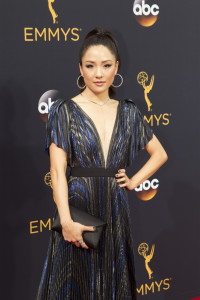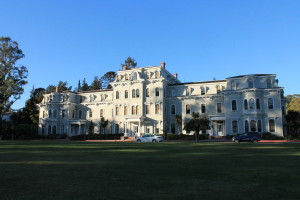
A stream of photos running across the Danforth lecture hall’s screen reveals rolls of film in lunch containers, soaking in different liquids. Experimental artist, Jennifer West, described the process as ‘marinating’ the film, some in urine, others in mixtures of random items – Gatorade, blueberries or wine – to wild and stunning effects.
On Wednesday, Feb. 15, West spoke at Mills, as the second speaker of the spring semester in the Art Lecture Series. She showed her work throughout the years, starting with Analogital 2016, going through some of her early films, then reaching her work on the New York Highline and more recent Movie Memories.
West got her bachelor’s degree from Evergreen State College in Olympia, Washington in 2004. Her experimental work with 16 mm, 35 mm and 70 mm film has been shown nationally, as well as internationally. She says that she has produced approximately 83 films so far.
Erin O’Malley, an MFA student at Mills, nominated West to come speak.
“I like that she takes a really fresh and experimental approach to filmmaking and the intersection of digital, analog and art,” O’Malley said. “I was very delighted to meet a person who is a radical, and has a strong interest in feminist history, and I feel that adds a dimension to the part of the artist that goes into the work.”
One of the first images West showed was her fridge. The fridge is a common place where film is stored, in order to prevent long-term storage damage or changes. She had years-old film in her fridge, and decided to get it tested to see how the film would look if developed.

“I was interested to see the film that had been carried around in three different states; I wanted to see if it lived,” West said. “I’ve done almost everything you can do to film.”
Like the marinades, West has mixed film with condiments. She has also dunked film in whiskey and perfume, had skateboarders skate over the film. She’s seen what film exposed to certain radiation would look like, and sewn film together in what she calls ‘film quilts.’
West and her art have changed over the years from black and white film, moving on to color. A common theme of her art is how it embodies a certain thing, whether it’s a place, her memories, or an experience. The film, and the ensuing art, is both an absorption and a projection of what it has gone through.
For her location work at the New York Highline, West taped down a mile long length of 35mm film for 17 hours, with the intent of editing the scuff marks into a film to show at the screening of the One Mile Film. Instead, something else happened.
“People decided immediately to start writing on it,” West said. “It ended up being a place for people to inscribe.”
The location was also a focus in her work, such as when she went to Spiral Jetty in Utah with film that had been soaking in water from the Dead Sea for five years. She drenched the film in the Great Salt Lake, and in this way, West connected the two bodies of water known for their high saline concentrations.
West has also worked with memories or ideas as the guiding concept in her art: With the ‘Whatever film,’ she took items that embodied the feeling of the word ‘whatever’ and treated the film with them. Similarly, in the “Double Fast Luck” film, West used items that were meant to bring luck, like certain ointments, on the film, exploring how luck has been commodified. Some of her recent work has been compiling a list of movies that made an impression on her, any kind of impression, and rewatching them. She has documented this journey, which she calls Movie Memories, on her Instagram.
“I thought that [Movie Memories] was hilarious,” Studio Art major Connie Lee said. “I enjoyed seeing so much of her process.”
Additionally, she makes zines to give out at her gallery exhibits, separate from the gallery work.
“It’s always been about the DIY ethos, instead of an attachment to the film production,” West said. “If I can subvert being in the art world, I don’t know.”
The next artist talk features Klea McKenna. The Art Lecture Series calendar can be found on the Mills College Art Museum’s website.



